Project Report: Design and Fabrication of Hydraulic Floor Crane
VerifiedAdded on 2020/05/16
|7
|1664
|875
Report
AI Summary
This report details a student's mechanical engineering project focused on designing and fabricating a hydraulic floor crane. The project aimed to overcome the limitations of traditional floor jib cranes, specifically addressing the issue of failure due to static loads. The student, as a project team member, was involved in various aspects, including researching components, designing the crane based on hydraulic principles, and ensuring proper execution of fabrication processes such as welding and assembling. The report outlines the objectives, the student's responsibilities, and the engineering knowledge applied, including the use of hydraulic cylinders, solenoid valves, and knowledge of fluid mechanics. The student also discusses challenges encountered, such as aeration in the hydraulic system, and the solutions implemented. The report highlights the collaborative nature of the project, emphasizing teamwork and coordination among team members. The project successfully resulted in a hydraulic crane capable of locking loads at various levels and enhancing material handling capabilities. The student's contributions included design, research, technical documentation, and problem-solving, leading to the project's successful completion and the development of innovative solutions to engineering challenges.
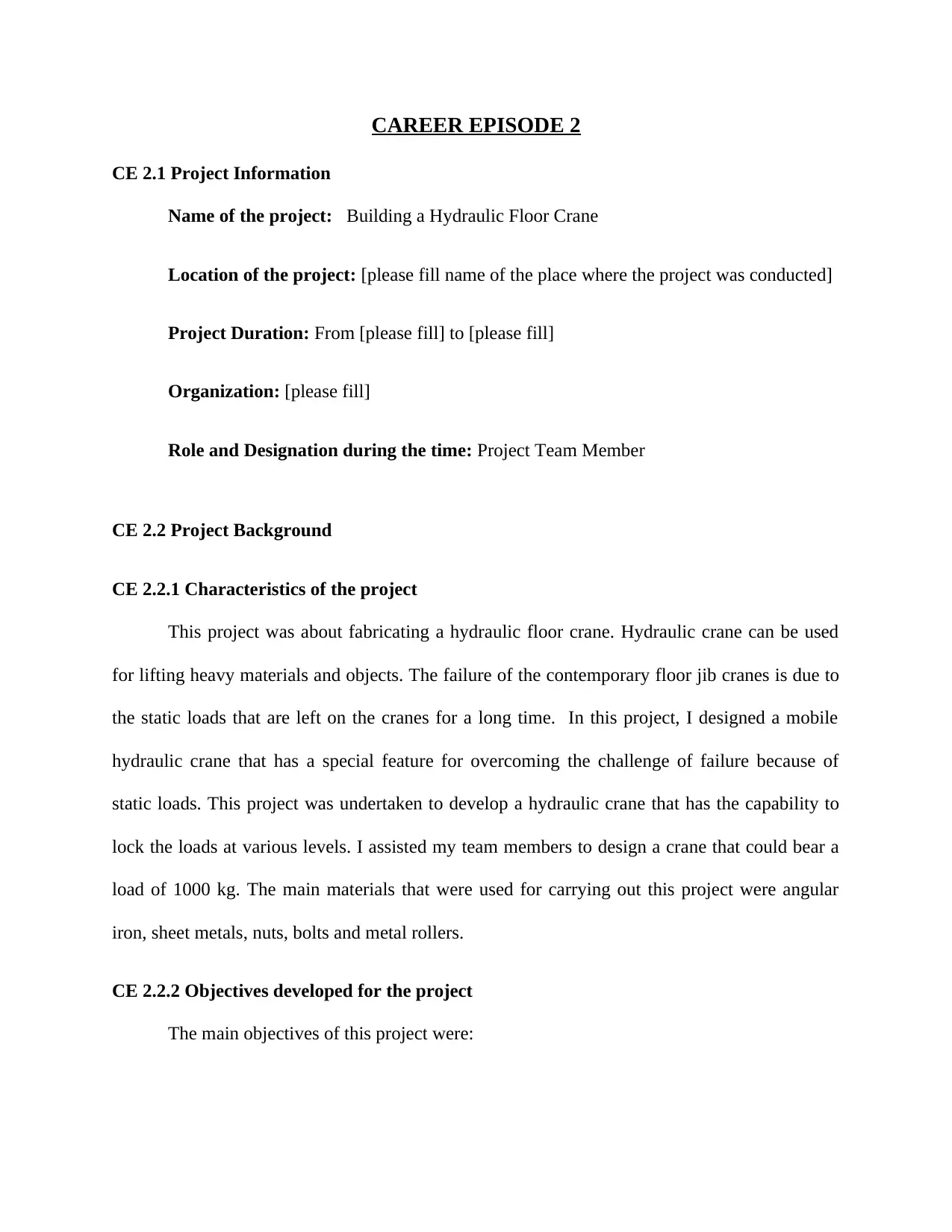
CAREER EPISODE 2
CE 2.1 Project Information
Name of the project: Building a Hydraulic Floor Crane
Location of the project: [please fill name of the place where the project was conducted]
Project Duration: From [please fill] to [please fill]
Organization: [please fill]
Role and Designation during the time: Project Team Member
CE 2.2 Project Background
CE 2.2.1 Characteristics of the project
This project was about fabricating a hydraulic floor crane. Hydraulic crane can be used
for lifting heavy materials and objects. The failure of the contemporary floor jib cranes is due to
the static loads that are left on the cranes for a long time. In this project, I designed a mobile
hydraulic crane that has a special feature for overcoming the challenge of failure because of
static loads. This project was undertaken to develop a hydraulic crane that has the capability to
lock the loads at various levels. I assisted my team members to design a crane that could bear a
load of 1000 kg. The main materials that were used for carrying out this project were angular
iron, sheet metals, nuts, bolts and metal rollers.
CE 2.2.2 Objectives developed for the project
The main objectives of this project were:
CE 2.1 Project Information
Name of the project: Building a Hydraulic Floor Crane
Location of the project: [please fill name of the place where the project was conducted]
Project Duration: From [please fill] to [please fill]
Organization: [please fill]
Role and Designation during the time: Project Team Member
CE 2.2 Project Background
CE 2.2.1 Characteristics of the project
This project was about fabricating a hydraulic floor crane. Hydraulic crane can be used
for lifting heavy materials and objects. The failure of the contemporary floor jib cranes is due to
the static loads that are left on the cranes for a long time. In this project, I designed a mobile
hydraulic crane that has a special feature for overcoming the challenge of failure because of
static loads. This project was undertaken to develop a hydraulic crane that has the capability to
lock the loads at various levels. I assisted my team members to design a crane that could bear a
load of 1000 kg. The main materials that were used for carrying out this project were angular
iron, sheet metals, nuts, bolts and metal rollers.
CE 2.2.2 Objectives developed for the project
The main objectives of this project were:
Paraphrase This Document
Need a fresh take? Get an instant paraphrase of this document with our AI Paraphraser
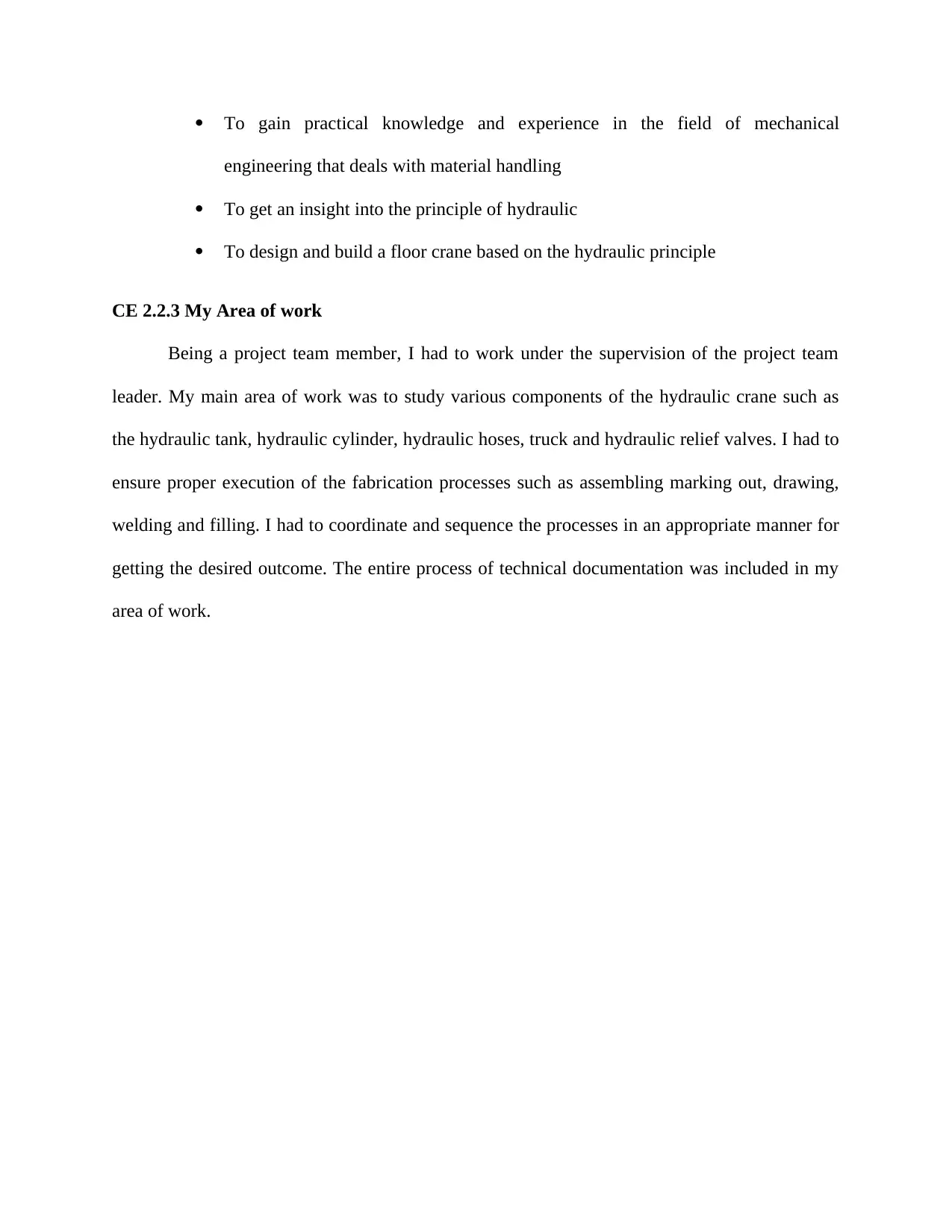
To gain practical knowledge and experience in the field of mechanical
engineering that deals with material handling
To get an insight into the principle of hydraulic
To design and build a floor crane based on the hydraulic principle
CE 2.2.3 My Area of work
Being a project team member, I had to work under the supervision of the project team
leader. My main area of work was to study various components of the hydraulic crane such as
the hydraulic tank, hydraulic cylinder, hydraulic hoses, truck and hydraulic relief valves. I had to
ensure proper execution of the fabrication processes such as assembling marking out, drawing,
welding and filling. I had to coordinate and sequence the processes in an appropriate manner for
getting the desired outcome. The entire process of technical documentation was included in my
area of work.
engineering that deals with material handling
To get an insight into the principle of hydraulic
To design and build a floor crane based on the hydraulic principle
CE 2.2.3 My Area of work
Being a project team member, I had to work under the supervision of the project team
leader. My main area of work was to study various components of the hydraulic crane such as
the hydraulic tank, hydraulic cylinder, hydraulic hoses, truck and hydraulic relief valves. I had to
ensure proper execution of the fabrication processes such as assembling marking out, drawing,
welding and filling. I had to coordinate and sequence the processes in an appropriate manner for
getting the desired outcome. The entire process of technical documentation was included in my
area of work.
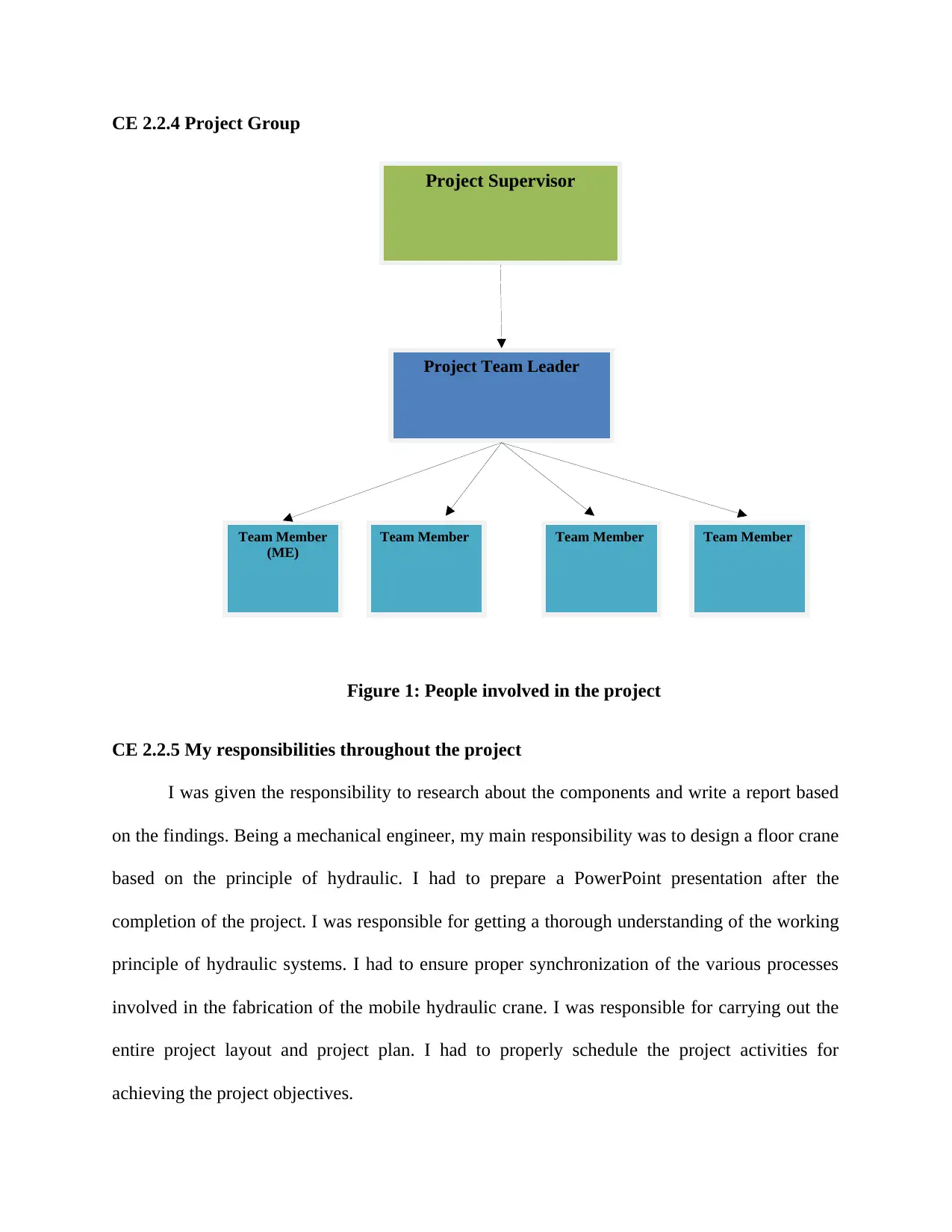
Project Supervisor
Project Team Leader
Team Member
(ME)
Team Member Team Member Team Member
CE 2.2.4 Project Group
Figure 1: People involved in the project
CE 2.2.5 My responsibilities throughout the project
I was given the responsibility to research about the components and write a report based
on the findings. Being a mechanical engineer, my main responsibility was to design a floor crane
based on the principle of hydraulic. I had to prepare a PowerPoint presentation after the
completion of the project. I was responsible for getting a thorough understanding of the working
principle of hydraulic systems. I had to ensure proper synchronization of the various processes
involved in the fabrication of the mobile hydraulic crane. I was responsible for carrying out the
entire project layout and project plan. I had to properly schedule the project activities for
achieving the project objectives.
Project Team Leader
Team Member
(ME)
Team Member Team Member Team Member
CE 2.2.4 Project Group
Figure 1: People involved in the project
CE 2.2.5 My responsibilities throughout the project
I was given the responsibility to research about the components and write a report based
on the findings. Being a mechanical engineer, my main responsibility was to design a floor crane
based on the principle of hydraulic. I had to prepare a PowerPoint presentation after the
completion of the project. I was responsible for getting a thorough understanding of the working
principle of hydraulic systems. I had to ensure proper synchronization of the various processes
involved in the fabrication of the mobile hydraulic crane. I was responsible for carrying out the
entire project layout and project plan. I had to properly schedule the project activities for
achieving the project objectives.
⊘ This is a preview!⊘
Do you want full access?
Subscribe today to unlock all pages.

Trusted by 1+ million students worldwide
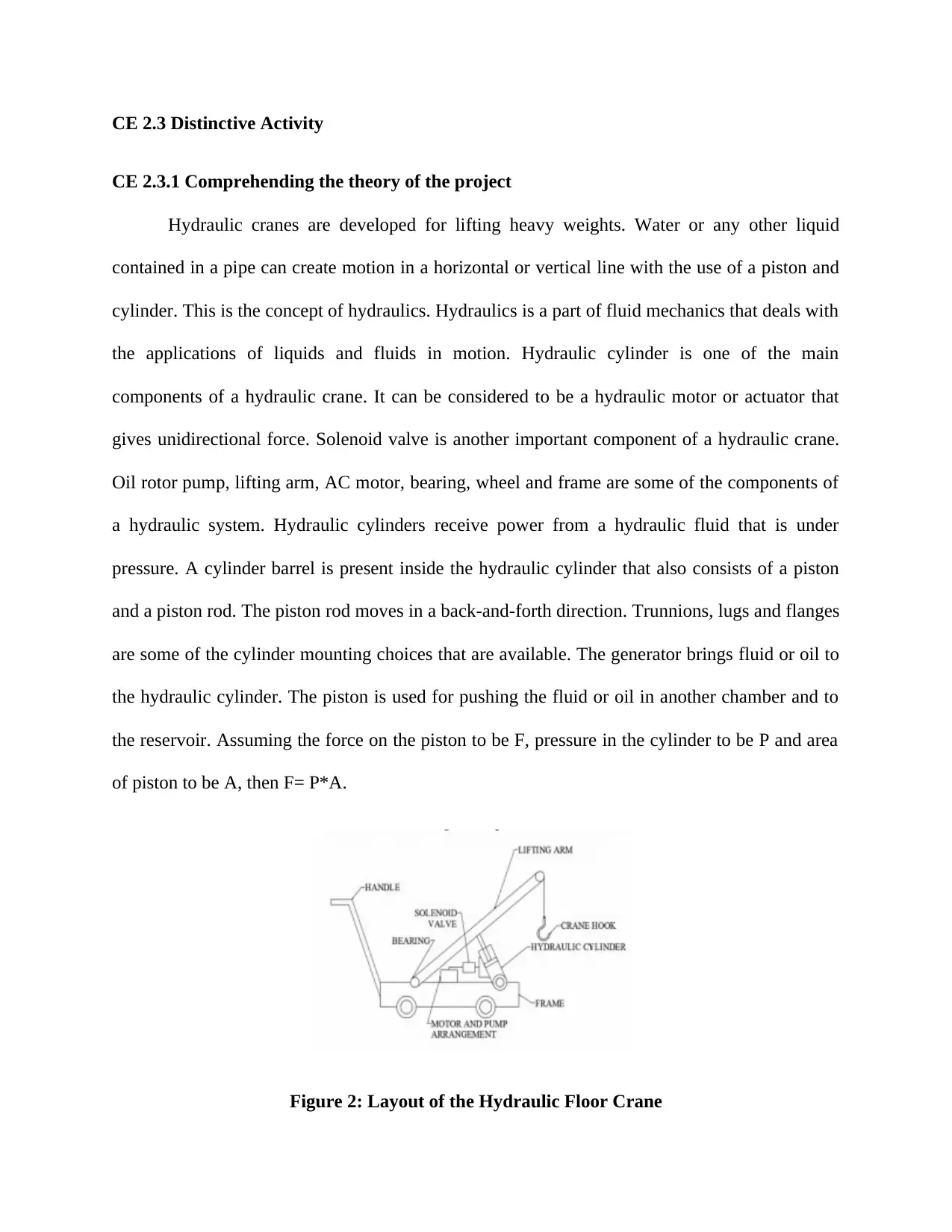
CE 2.3 Distinctive Activity
CE 2.3.1 Comprehending the theory of the project
Hydraulic cranes are developed for lifting heavy weights. Water or any other liquid
contained in a pipe can create motion in a horizontal or vertical line with the use of a piston and
cylinder. This is the concept of hydraulics. Hydraulics is a part of fluid mechanics that deals with
the applications of liquids and fluids in motion. Hydraulic cylinder is one of the main
components of a hydraulic crane. It can be considered to be a hydraulic motor or actuator that
gives unidirectional force. Solenoid valve is another important component of a hydraulic crane.
Oil rotor pump, lifting arm, AC motor, bearing, wheel and frame are some of the components of
a hydraulic system. Hydraulic cylinders receive power from a hydraulic fluid that is under
pressure. A cylinder barrel is present inside the hydraulic cylinder that also consists of a piston
and a piston rod. The piston rod moves in a back-and-forth direction. Trunnions, lugs and flanges
are some of the cylinder mounting choices that are available. The generator brings fluid or oil to
the hydraulic cylinder. The piston is used for pushing the fluid or oil in another chamber and to
the reservoir. Assuming the force on the piston to be F, pressure in the cylinder to be P and area
of piston to be A, then F= P*A.
Figure 2: Layout of the Hydraulic Floor Crane
CE 2.3.1 Comprehending the theory of the project
Hydraulic cranes are developed for lifting heavy weights. Water or any other liquid
contained in a pipe can create motion in a horizontal or vertical line with the use of a piston and
cylinder. This is the concept of hydraulics. Hydraulics is a part of fluid mechanics that deals with
the applications of liquids and fluids in motion. Hydraulic cylinder is one of the main
components of a hydraulic crane. It can be considered to be a hydraulic motor or actuator that
gives unidirectional force. Solenoid valve is another important component of a hydraulic crane.
Oil rotor pump, lifting arm, AC motor, bearing, wheel and frame are some of the components of
a hydraulic system. Hydraulic cylinders receive power from a hydraulic fluid that is under
pressure. A cylinder barrel is present inside the hydraulic cylinder that also consists of a piston
and a piston rod. The piston rod moves in a back-and-forth direction. Trunnions, lugs and flanges
are some of the cylinder mounting choices that are available. The generator brings fluid or oil to
the hydraulic cylinder. The piston is used for pushing the fluid or oil in another chamber and to
the reservoir. Assuming the force on the piston to be F, pressure in the cylinder to be P and area
of piston to be A, then F= P*A.
Figure 2: Layout of the Hydraulic Floor Crane
Paraphrase This Document
Need a fresh take? Get an instant paraphrase of this document with our AI Paraphraser
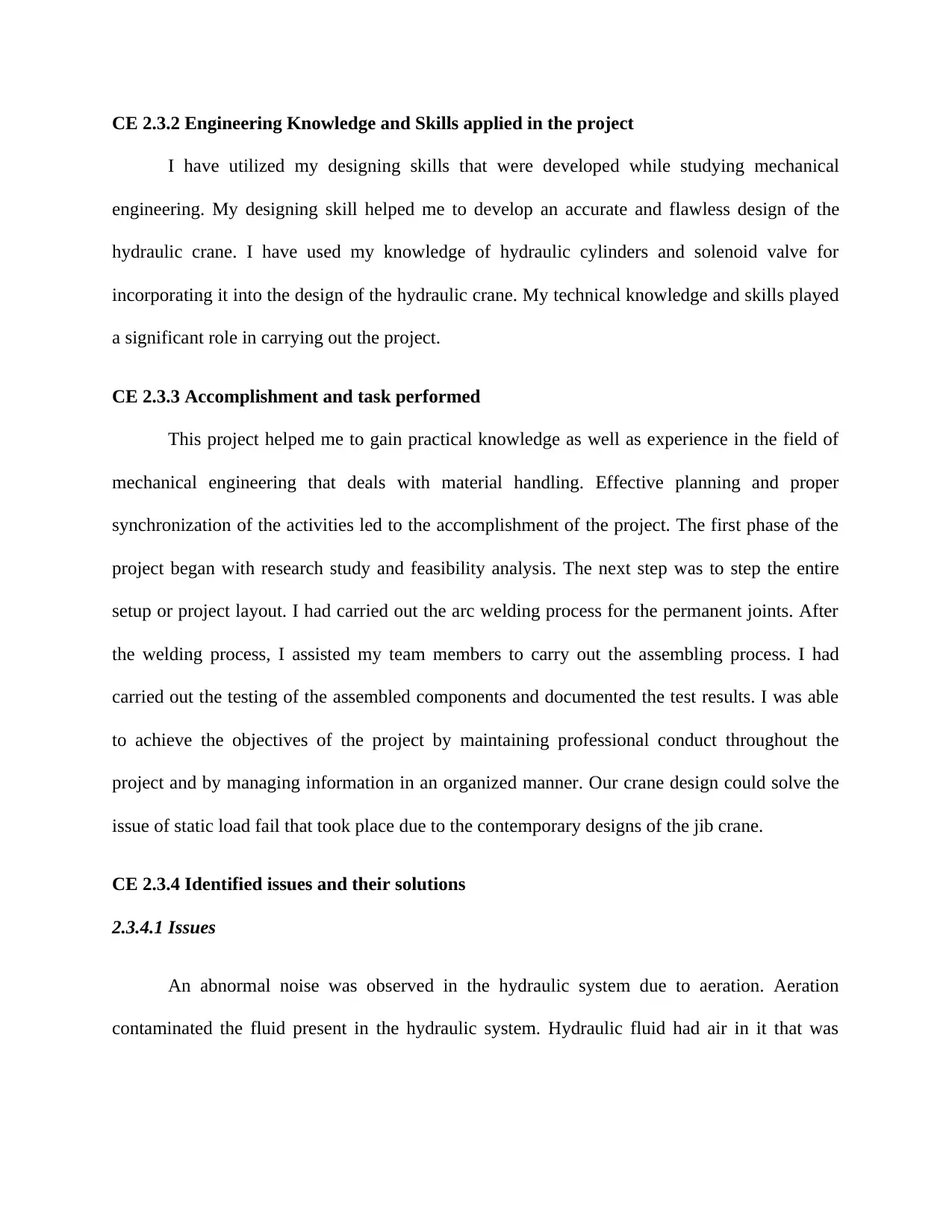
CE 2.3.2 Engineering Knowledge and Skills applied in the project
I have utilized my designing skills that were developed while studying mechanical
engineering. My designing skill helped me to develop an accurate and flawless design of the
hydraulic crane. I have used my knowledge of hydraulic cylinders and solenoid valve for
incorporating it into the design of the hydraulic crane. My technical knowledge and skills played
a significant role in carrying out the project.
CE 2.3.3 Accomplishment and task performed
This project helped me to gain practical knowledge as well as experience in the field of
mechanical engineering that deals with material handling. Effective planning and proper
synchronization of the activities led to the accomplishment of the project. The first phase of the
project began with research study and feasibility analysis. The next step was to step the entire
setup or project layout. I had carried out the arc welding process for the permanent joints. After
the welding process, I assisted my team members to carry out the assembling process. I had
carried out the testing of the assembled components and documented the test results. I was able
to achieve the objectives of the project by maintaining professional conduct throughout the
project and by managing information in an organized manner. Our crane design could solve the
issue of static load fail that took place due to the contemporary designs of the jib crane.
CE 2.3.4 Identified issues and their solutions
2.3.4.1 Issues
An abnormal noise was observed in the hydraulic system due to aeration. Aeration
contaminated the fluid present in the hydraulic system. Hydraulic fluid had air in it that was
I have utilized my designing skills that were developed while studying mechanical
engineering. My designing skill helped me to develop an accurate and flawless design of the
hydraulic crane. I have used my knowledge of hydraulic cylinders and solenoid valve for
incorporating it into the design of the hydraulic crane. My technical knowledge and skills played
a significant role in carrying out the project.
CE 2.3.3 Accomplishment and task performed
This project helped me to gain practical knowledge as well as experience in the field of
mechanical engineering that deals with material handling. Effective planning and proper
synchronization of the activities led to the accomplishment of the project. The first phase of the
project began with research study and feasibility analysis. The next step was to step the entire
setup or project layout. I had carried out the arc welding process for the permanent joints. After
the welding process, I assisted my team members to carry out the assembling process. I had
carried out the testing of the assembled components and documented the test results. I was able
to achieve the objectives of the project by maintaining professional conduct throughout the
project and by managing information in an organized manner. Our crane design could solve the
issue of static load fail that took place due to the contemporary designs of the jib crane.
CE 2.3.4 Identified issues and their solutions
2.3.4.1 Issues
An abnormal noise was observed in the hydraulic system due to aeration. Aeration
contaminated the fluid present in the hydraulic system. Hydraulic fluid had air in it that was
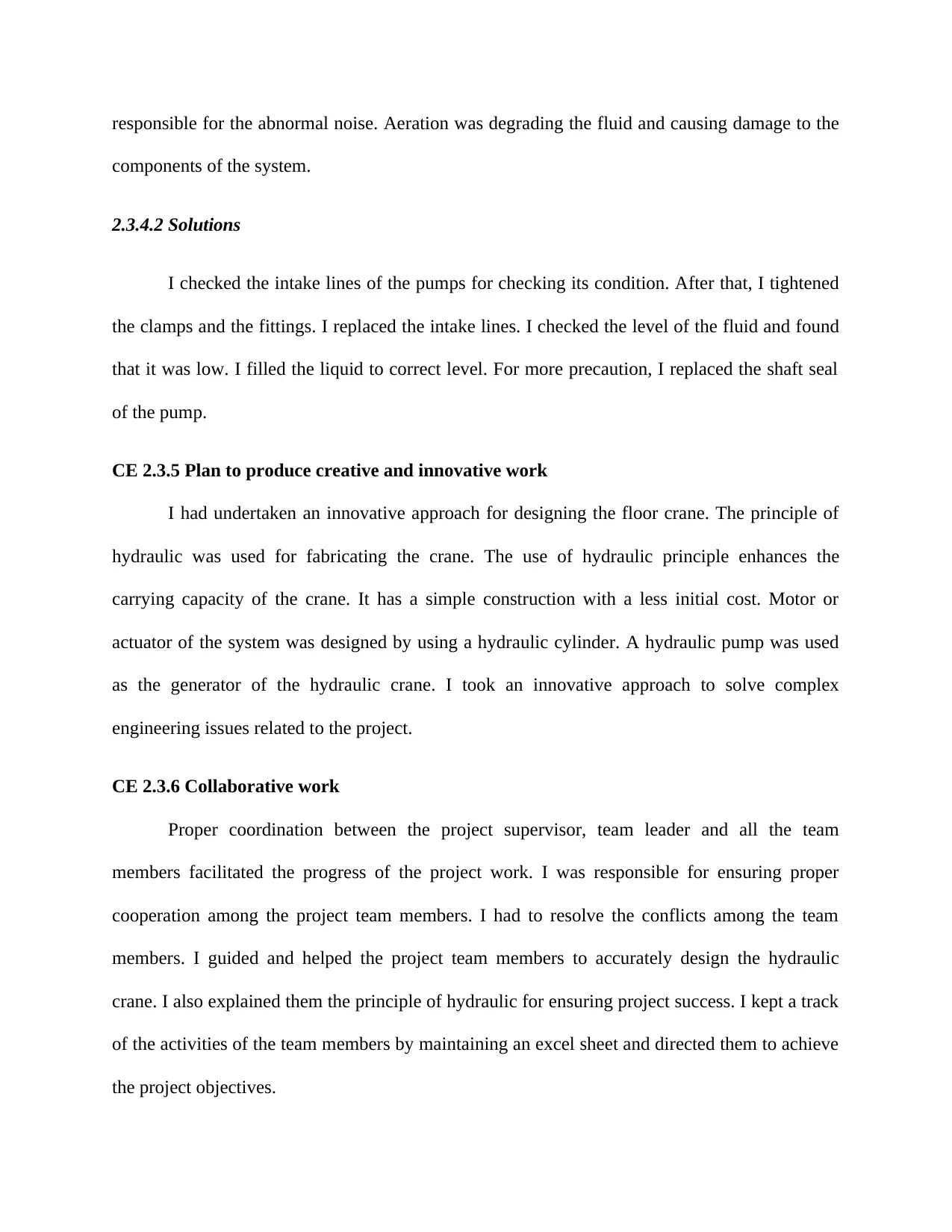
responsible for the abnormal noise. Aeration was degrading the fluid and causing damage to the
components of the system.
2.3.4.2 Solutions
I checked the intake lines of the pumps for checking its condition. After that, I tightened
the clamps and the fittings. I replaced the intake lines. I checked the level of the fluid and found
that it was low. I filled the liquid to correct level. For more precaution, I replaced the shaft seal
of the pump.
CE 2.3.5 Plan to produce creative and innovative work
I had undertaken an innovative approach for designing the floor crane. The principle of
hydraulic was used for fabricating the crane. The use of hydraulic principle enhances the
carrying capacity of the crane. It has a simple construction with a less initial cost. Motor or
actuator of the system was designed by using a hydraulic cylinder. A hydraulic pump was used
as the generator of the hydraulic crane. I took an innovative approach to solve complex
engineering issues related to the project.
CE 2.3.6 Collaborative work
Proper coordination between the project supervisor, team leader and all the team
members facilitated the progress of the project work. I was responsible for ensuring proper
cooperation among the project team members. I had to resolve the conflicts among the team
members. I guided and helped the project team members to accurately design the hydraulic
crane. I also explained them the principle of hydraulic for ensuring project success. I kept a track
of the activities of the team members by maintaining an excel sheet and directed them to achieve
the project objectives.
components of the system.
2.3.4.2 Solutions
I checked the intake lines of the pumps for checking its condition. After that, I tightened
the clamps and the fittings. I replaced the intake lines. I checked the level of the fluid and found
that it was low. I filled the liquid to correct level. For more precaution, I replaced the shaft seal
of the pump.
CE 2.3.5 Plan to produce creative and innovative work
I had undertaken an innovative approach for designing the floor crane. The principle of
hydraulic was used for fabricating the crane. The use of hydraulic principle enhances the
carrying capacity of the crane. It has a simple construction with a less initial cost. Motor or
actuator of the system was designed by using a hydraulic cylinder. A hydraulic pump was used
as the generator of the hydraulic crane. I took an innovative approach to solve complex
engineering issues related to the project.
CE 2.3.6 Collaborative work
Proper coordination between the project supervisor, team leader and all the team
members facilitated the progress of the project work. I was responsible for ensuring proper
cooperation among the project team members. I had to resolve the conflicts among the team
members. I guided and helped the project team members to accurately design the hydraulic
crane. I also explained them the principle of hydraulic for ensuring project success. I kept a track
of the activities of the team members by maintaining an excel sheet and directed them to achieve
the project objectives.
⊘ This is a preview!⊘
Do you want full access?
Subscribe today to unlock all pages.

Trusted by 1+ million students worldwide
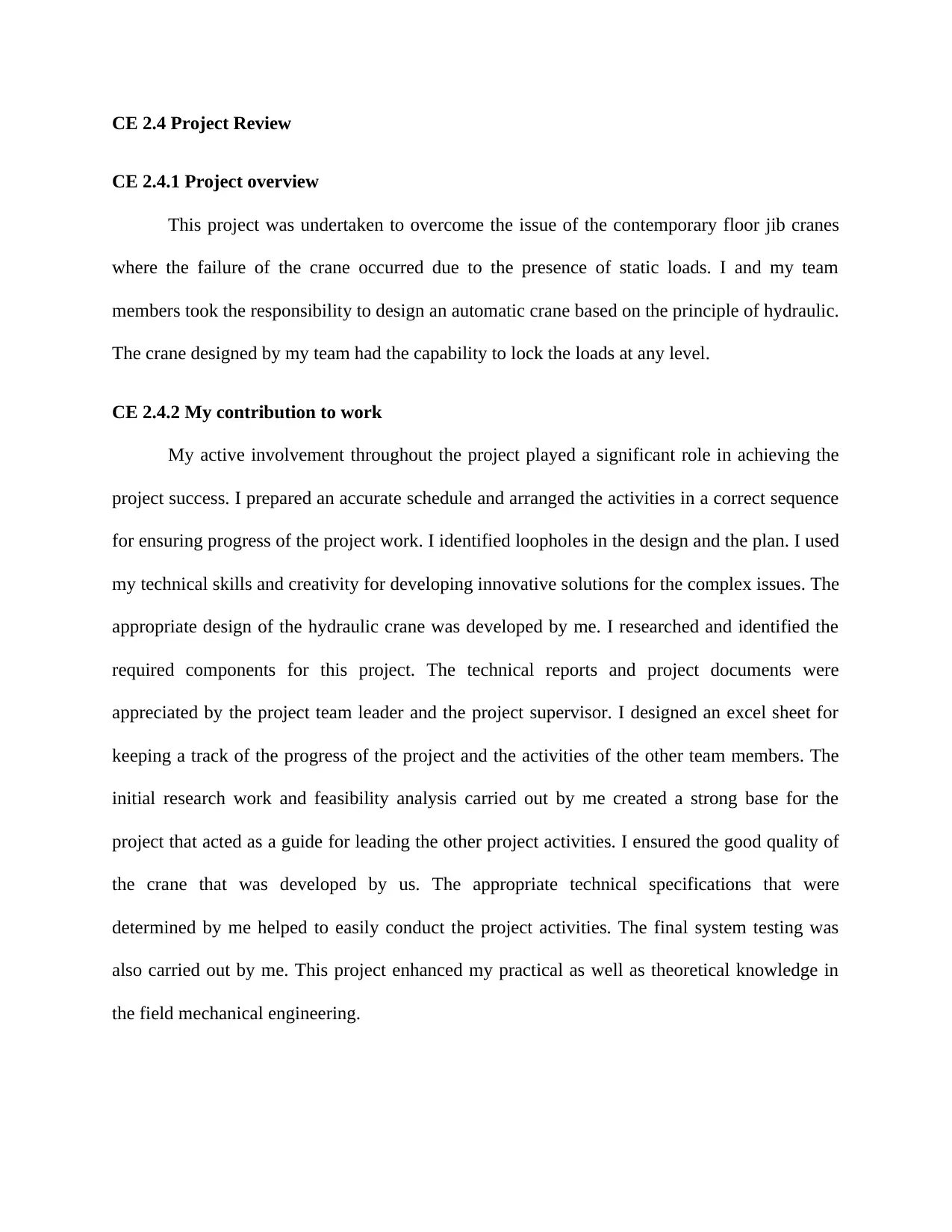
CE 2.4 Project Review
CE 2.4.1 Project overview
This project was undertaken to overcome the issue of the contemporary floor jib cranes
where the failure of the crane occurred due to the presence of static loads. I and my team
members took the responsibility to design an automatic crane based on the principle of hydraulic.
The crane designed by my team had the capability to lock the loads at any level.
CE 2.4.2 My contribution to work
My active involvement throughout the project played a significant role in achieving the
project success. I prepared an accurate schedule and arranged the activities in a correct sequence
for ensuring progress of the project work. I identified loopholes in the design and the plan. I used
my technical skills and creativity for developing innovative solutions for the complex issues. The
appropriate design of the hydraulic crane was developed by me. I researched and identified the
required components for this project. The technical reports and project documents were
appreciated by the project team leader and the project supervisor. I designed an excel sheet for
keeping a track of the progress of the project and the activities of the other team members. The
initial research work and feasibility analysis carried out by me created a strong base for the
project that acted as a guide for leading the other project activities. I ensured the good quality of
the crane that was developed by us. The appropriate technical specifications that were
determined by me helped to easily conduct the project activities. The final system testing was
also carried out by me. This project enhanced my practical as well as theoretical knowledge in
the field mechanical engineering.
CE 2.4.1 Project overview
This project was undertaken to overcome the issue of the contemporary floor jib cranes
where the failure of the crane occurred due to the presence of static loads. I and my team
members took the responsibility to design an automatic crane based on the principle of hydraulic.
The crane designed by my team had the capability to lock the loads at any level.
CE 2.4.2 My contribution to work
My active involvement throughout the project played a significant role in achieving the
project success. I prepared an accurate schedule and arranged the activities in a correct sequence
for ensuring progress of the project work. I identified loopholes in the design and the plan. I used
my technical skills and creativity for developing innovative solutions for the complex issues. The
appropriate design of the hydraulic crane was developed by me. I researched and identified the
required components for this project. The technical reports and project documents were
appreciated by the project team leader and the project supervisor. I designed an excel sheet for
keeping a track of the progress of the project and the activities of the other team members. The
initial research work and feasibility analysis carried out by me created a strong base for the
project that acted as a guide for leading the other project activities. I ensured the good quality of
the crane that was developed by us. The appropriate technical specifications that were
determined by me helped to easily conduct the project activities. The final system testing was
also carried out by me. This project enhanced my practical as well as theoretical knowledge in
the field mechanical engineering.
1 out of 7
Related Documents
Your All-in-One AI-Powered Toolkit for Academic Success.
+13062052269
info@desklib.com
Available 24*7 on WhatsApp / Email
![[object Object]](/_next/static/media/star-bottom.7253800d.svg)
Unlock your academic potential
Copyright © 2020–2025 A2Z Services. All Rights Reserved. Developed and managed by ZUCOL.





